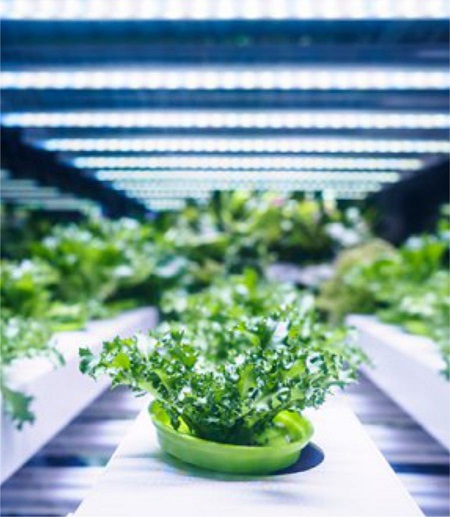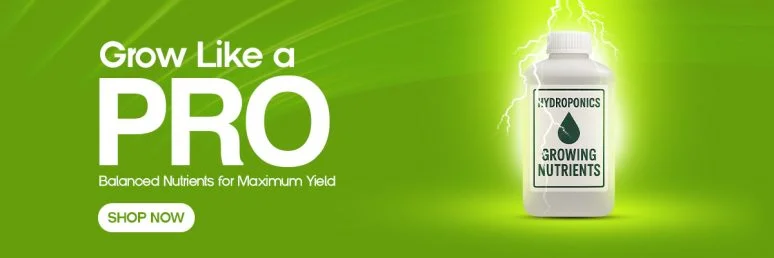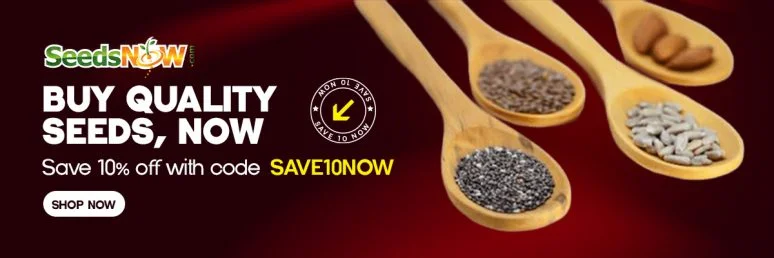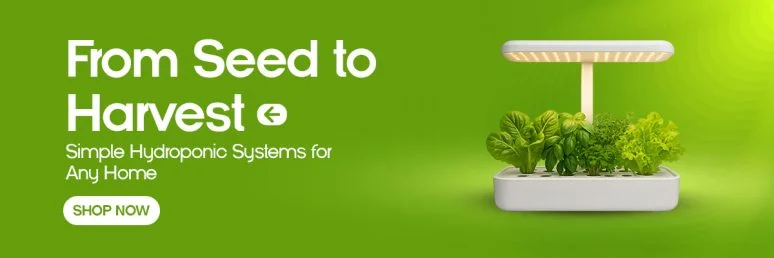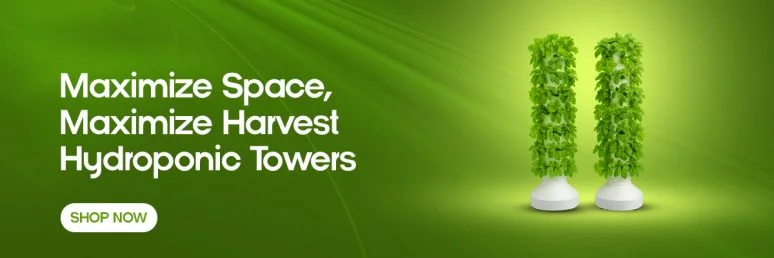Optimizing Light Intensity for Hydroponic Growing: Learn How

Key Takeaways
- Plants require different PPFD levels throughout their growth cycle, ranging from 100-300 μmol/m²/s for seedlings to 600-900+ μmol/m²/s for flowering plants.
- Measuring light intensity using PAR meters rather than lux meters provides more accurate readings of usable light for plant photosynthesis.
- Properly adjusting light height and intensity as plants grow prevents both light stress and stretching from inadequate light.
- Different hydroponic crops have specific light requirements – leafy greens need 250-450 PPFD while fruiting plants require 600-900 PPFD for optimal yields.
- Creating a light map of your growing area helps identify and correct hotspots and shadows that can affect plant growth uniformity.
Getting the light intensity right in hydroponic systems isn’t just helpful—it’s essential for maximizing plant health and yield. Without soil as a buffer, hydroponic plants rely entirely on you to provide the perfect growing environment, with light being among the most critical factors.
Perfect light intensity varies dramatically depending on plant type, growth stage, and environmental conditions. While some beginners mistakenly think “more light equals better plants,” this approach can actually stress plants and reduce yields. Understanding the science behind light measurement and plant needs will transform your growing results.
Why Proper Light Intensity Makes or Breaks Your Hydroponic Garden
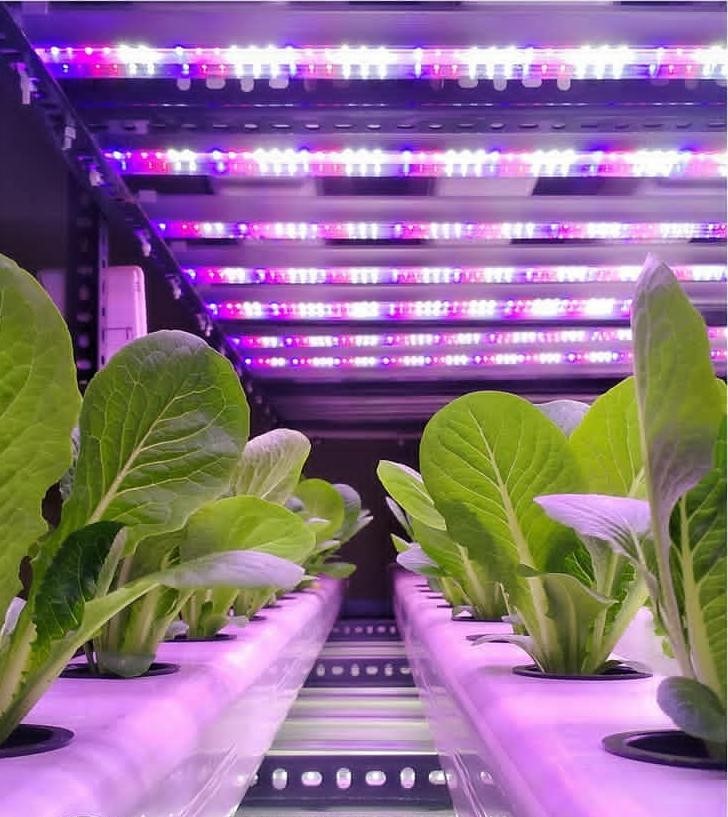
“Hydroponics Grow Light – Red blue …” from www.wehydroponics.com and used with no modifications.
Light isn’t just important—it’s the engine that powers your entire hydroponic operation. Plants convert light energy into chemical energy through photosynthesis, directly influencing how quickly they grow, how strong they become, and ultimately how much they yield. Too little light and plants stretch, becoming lanky and weak. Too much light and they develop light stress, stunting growth and reducing harvests.
In soil gardens, many environmental factors can be buffered or corrected naturally. In hydroponics, you control everything—which means light mistakes become amplified. When I first started with hydroponics, I made the classic error of using the same light intensity throughout the entire growth cycle. My seedlings struggled with light burn while my fruiting plants produced smaller yields than they should have.
Your lighting system represents one of your largest investments in hydroponics, both in terms of purchase cost and ongoing electricity usage. By optimizing intensity, you not only improve plant results but also maximize energy efficiency—getting more growth per kilowatt-hour of electricity. Proper light management can reduce electricity costs by 20-30% while simultaneously improving yields.
The Science Behind Light Intensity in Hydroponics
“Hydroponics Grow Light – Full Spectrum …” from www.wehydroponics.com and used with no modifications.
Understanding light intensity means learning to speak the language of photons and photosynthesis. Forget about watts and lumens—these measurements were designed for human eyes, not plant growth. Instead, we need to focus on measurements that directly relate to photosynthesis.
What PPFD Actually Measures and Why It Matters
PPFD (Photosynthetic Photon Flux Density) measures the number of photons in the photosynthetically active radiation (PAR) range that hit a square meter of your plants each second. It’s expressed in micromoles per square meter per second (μmol/m²/s) and provides the most accurate measurement of usable light for plants. Think of PPFD as counting the exact number of “light particles” your plants can use for photosynthesis.
Unlike lumens or lux which measure brightness as perceived by human eyes, PPFD specifically counts the photons that drive photosynthesis (wavelengths between 400-700nm). This distinction is crucial because plants use different parts of the light spectrum than what appears brightest to our eyes. A grow light that looks incredibly bright to you might actually provide less usable photosynthetic energy than a dimmer-looking light with the right spectrum.
DLI (Daily Light Integral): The Total Light Your Plants Receive
While PPFD measures instantaneous light intensity, plants respond to their total daily exposure—this is where DLI (Daily Light Integral) becomes important. DLI represents the cumulative amount of PAR received during a 24-hour period, measured in moles of photons per square meter per day (mol/m²/d). Think of PPFD as the rate of light delivery, while DLI is the total package delivered.
Most hydroponic crops need a DLI between 10-30 mol/m²/d depending on the plant and growth stage. You can achieve the same DLI with different approaches: high intensity for shorter periods or moderate intensity for longer periods. This flexibility allows you to tailor lighting schedules to match your plants’ needs and your energy constraints.
Understanding DLI helps explain why plants in a greenhouse during cloudy winter days grow slowly despite seemingly adequate lighting—they’re simply not receiving enough total light energy over the course of each day. In contrast, summer greenhouses may require shading to prevent excessive DLI that could stress plants.
How Different Light Spectrums Affect Plant Growth
Light intensity doesn’t tell the complete story—spectrum matters too. Different wavelengths trigger specific responses in plants beyond just powering photosynthesis. Blue light (400-500nm) promotes compact, stocky growth and is essential during vegetative stages. Red light (600-700nm) drives flowering and fruiting processes, making it critical during reproductive phases.
Full-spectrum LED grow lights now dominate the hydroponic industry because they provide the complete range of wavelengths plants need while allowing growers to adjust intensity. Some advanced systems even allow spectrum tuning to optimize for different growth stages. For most home growers, a quality full-spectrum LED with adjustable intensity provides the best balance of performance and simplicity.
Light Requirements Through Growth Stages
“Full Spectrum Hydroponic Grow Light …” from www.indiamart.com and used with no modifications.
Understanding that plants need different light intensities as they mature is key to successful hydroponic growing. Just as a human infant has different nutritional needs than an adult, plants require changing light conditions throughout their lifecycle to thrive.
Each growth stage has specific light intensity requirements that optimize growth while preventing stress. Following these stage-specific guidelines can dramatically improve your yields while reducing common light-related problems.
Seedling Stage: 100-300 PPFD (Gentle Light Prevents Burning)
Seedlings and young clones are incredibly vulnerable to light stress. Their leaves are thin, their root systems undeveloped, and their ability to process intense light limited. During this delicate stage, maintaining PPFD levels between 100-300 μmol/m²/s provides enough energy for healthy development without overwhelming their immature systems.
I’ve found that starting at the lower end (around 100-150 PPFD) for the first week before gradually increasing intensity produces the strongest seedlings. This approach mimics nature, where seedlings often begin life in the shade of larger plants. Too much light too soon results in stunted, bleached seedlings that never recover to their full potential. For more insights on nurturing seedlings, check out these hydroponic seed germination practices.
During this stage, positioning lights 24-36 inches above seedlings typically achieves the ideal intensity, but always verify with measurements. Seedlings also benefit from slightly longer photoperiods of 18-24 hours, as the lower intensity can be partially compensated for with increased duration.
Vegetative Growth: 300-600 PPFD (Building Strong Foundations)
Once plants establish their first true leaves and begin active vegetative growth, they can handle—and indeed require—more intense light. During this stage, aim for PPFD levels between 300-600 μmol/m²/s, gradually increasing as plants develop stronger stems and larger leaf surfaces.
This moderate intensity encourages lateral growth, strong stem development, and robust root systems. The goal during vegetation is to build a strong foundation for future flowering or fruiting. Plants that receive optimal light during this stage develop more bud sites, stronger branches that can support heavy fruits, and greater overall resilience.
For most vegetative plants, a photoperiod of 16-18 hours provides excellent results. As plants grow taller, you’ll need to maintain proper light distance—typically 18-24 inches for most LED systems—adjusting weekly to accommodate growth.
Flowering and Fruiting: 600-900+ PPFD (Maximum Energy for Production)
The flowering and fruiting stage demands the highest light intensity of the entire growth cycle. Plants need tremendous energy to produce flowers, fruits, and seeds—their reproductive structures. During this crucial phase, increasing PPFD to 600-900+ μmol/m²/s can significantly boost yields and improve quality.
High-value crops like tomatoes, peppers, and cannabis can benefit from even higher intensities up to 1000 μmol/m²/s when combined with supplemental CO2. However, at these extreme intensities, temperature management becomes critical, as plants can quickly overheat under intense light.
During flowering, most plants prefer shorter photoperiods of 12 hours, which signals it’s time to reproduce while providing intense light when they can most efficiently use it. Positioning lights 12-18 inches from the canopy typically achieves optimal intensity for flowering plants, though this varies by light model.
Common Light Intensity Mistakes That Kill Yields
Even experienced hydroponic growers make lighting mistakes that significantly impact their harvests. Recognizing these common pitfalls can help you avoid weeks of frustrated troubleshooting and disappointing yields.
Too Much Light: Symptoms of Light Stress
Contrary to popular belief, more light isn’t always better. Light stress symptoms often begin with leaf edges curling upward (tacoing) and yellow or white patches appearing on upper leaves closest to lights. As stress progresses, leaves may develop brown scorched edges, and growth slows dramatically despite seemingly ideal conditions.
Advanced light stress can be mistaken for nutrient deficiencies, leading growers to adjust their feeding regimens when the real solution is simply raising lights or reducing intensity. If you notice the uppermost leaves showing symptoms while lower leaves remain healthy, light stress is the likely culprit.
Too Little Light: Signs Your Plants Are Light-Starved
Insufficient light produces telltale stretching as plants desperately reach toward light sources. Stems become unusually long and weak between leaf nodes (internodal spacing), while leaves grow larger but thinner in an attempt to capture more light. This stretching creates structurally weak plants that can’t support heavy fruit loads and are more susceptible to pests and diseases.
Light-starved plants also develop pale, yellowish-green leaves instead of the deep, vibrant green of healthy foliage. Production suffers dramatically, with fewer flowers, smaller fruits, and delayed harvests. Many growers mistakenly address these symptoms with additional nitrogen, which only exacerbates the stretching problem.
Inconsistent Light Distribution Across Your Growing Area
One of the most overlooked lighting issues is uneven distribution, which creates “hot spots” and shadows in your growing area. Plants under the same light fixture can experience drastically different PPFD levels, leading to inconsistent growth rates and harvests. This problem becomes especially pronounced as growing areas expand beyond a single light.
Proper light overlap between fixtures is essential for uniform growth. Without it, plants at the periphery receive significantly less light than those in the center, creating management challenges as plants develop at different rates. Using light reflectors, arranging fixtures in optimal patterns, and ensuring proper hanging height all contribute to more uniform light distribution.
Failing to Adjust Intensity as Plants Grow Taller
As plants grow taller, they get closer to light sources—dramatically increasing the PPFD they receive even though you haven’t changed any settings. This natural progression means light intensity must be continually adjusted throughout the growth cycle by raising fixtures or reducing power to maintain optimal levels.
Tools to Measure Light Intensity Accurately
Professional hydroponic growing requires moving beyond guesswork when it comes to light intensity. Proper measurement tools allow you to verify that your plants receive optimal light levels regardless of growing environment or light type.
The investment in quality measurement tools pays dividends through improved plant health, faster growth cycles, and significantly higher yields. Even basic measurements can reveal problems invisible to the naked eye.
Modern digital tools have made professional-grade measurements accessible to hobbyists and small-scale growers at reasonable prices. These tools eliminate the guesswork that plagues many hydroponic setups.
- PAR meters for accurate PPFD measurement
- Smartphone light meter apps for basic readings
- Light mapping grids for understanding distribution
- Spectral analysis tools for advanced applications
- Automated sensors for continuous monitoring
PAR Meters: Professional-Grade Measurement
PAR meters are the gold standard for measuring light in hydroponic settings. These specialized devices measure PPFD directly, giving you precise readings of the photosynthetically active radiation reaching your plants. Professional models from manufacturers like Apogee Instruments provide accurate readings across different light spectrums, including LED, HPS, CMH, and natural sunlight.
While quality PAR meters represent a significant investment ($300-800), they eliminate guesswork and allow precise tuning of light systems. Many commercial growers find PAR meters pay for themselves in a single growing cycle through improved yields and reduced electricity costs. For serious hobbyists, more affordable options like the Hydrofarm Quantum PAR meter offer good accuracy at lower price points.
Smartphone Light Meters: Budget-Friendly Options
For beginners or those on tight budgets, smartphone-based PAR meter attachments and apps provide an affordable entry point to light measurement. Devices like the Photone app (which uses your phone’s camera as a sensor) can provide reasonably accurate readings after calibration, especially when used consistently in the same environment with the same light types.
While not as accurate as dedicated PAR meters, these budget options still provide valuable comparative readings that help identify problems and track adjustments. They’re particularly useful for detecting relative changes in light levels as plants grow taller or when adjusting fixture heights. Always remember that phone-based readings may have 10-20% variance from professional equipment, so build in safety margins when using these tools. For more insights, check out this guide on light intensity.
Creating a Light Map for Your Growing Space
Rather than taking isolated readings, creating a complete light map of your growing area reveals hotspots, shadows, and variations that affect plant development. To create a basic light map, divide your growing area into a grid (typically 1’×1′ squares) and take PPFD measurements at each intersection point, recording them in a diagram of your space.
This mapping process often reveals surprising patterns, such as dramatic light falloff at edges, unexpected shadows, or intensity variations between seemingly identical fixtures. With a comprehensive light map, you can rearrange plants according to their light needs, adjust fixture positions to eliminate hotspots, and add supplemental lighting where needed. For larger operations, 3D light mapping software can create detailed visualizations of your light environment, though these typically require professional consultation.
Using Dimmers and Controllers
Dimmer switches and digital controllers offer the most precise way to adjust light intensity without physically moving fixtures. Modern LED grow lights typically feature built-in dimming capabilities or compatibility with external controllers that allow adjustments from 10-100% of maximum output. This flexibility enables you to fine-tune intensity throughout the growing cycle without stress or interruption to your plants. When selecting a lighting system, prioritize models with smooth dimming that maintains spectrum balance at lower intensities, as cheaper systems may shift spectrum dramatically when dimmed.
Arranging Plants Based on Light Needs
Strategic plant arrangement can solve many light distribution challenges without requiring additional equipment. Place light-hungry plants (like tomatoes or peppers) directly under fixture centers where intensity is highest. Position less demanding plants (like lettuce or herbs) around the periphery where light levels naturally decrease. This approach maximizes yield by matching each plant’s specific light requirements to the available intensity in different parts of your growing area. For vertical systems, remember that lower tiers receive significantly less light than upper levels, requiring either supplemental lighting or appropriate plant selection for each tier.
Advanced Strategies for Light Intensity Management
“LED Grow Lights V.S. Other Hydroponic …” from gathera.com and used with no modifications.
Once you’ve mastered the basics of light intensity, implementing advanced strategies can push your hydroponic system to commercial-level productivity. These techniques go beyond simply providing adequate light—they optimize every photon for maximum growth efficiency and yield quality.
Advanced light management integrates with other environmental factors to create ideal growing conditions. When properly executed, these strategies can reduce growing time by up to 30% while improving nutritional content and flavor profiles in edible crops.
- Light schedules synchronized with nutrient delivery
- Dynamic light adjustment based on plant feedback
- Light spectrum shifting through growth phases
- Pulsed lighting techniques for energy efficiency
- Integrated light and temperature management
Commercial growers regularly implement these techniques, but they’re increasingly accessible to serious hobbyists with modern equipment. The key is systematic implementation and careful observation of plant responses, adjusting protocols based on results rather than rigidly following prescribed formulas. For more insights, explore hydroponics explained to understand the basics of this growing method.
Progressive Intensity Scheduling
Progressive intensity scheduling gradually increases light levels throughout the day, mimicking the natural intensification of sunlight from morning to midday. Rather than immediately turning lights on at full power, this approach ramps up intensity over 1-2 hours in the morning and gradually decreases in the evening. This technique reduces plant stress while maximizing photosynthetic efficiency, as plants utilize moderate morning light more efficiently than being suddenly exposed to full intensity.
Sample Progressive Light Schedule (Flowering Plants)
Hour 1: 30% intensity (300 PPFD) – Morning activation
Hours 2-3: 60% intensity (500 PPFD) – Warming period
Hours 4-9: 100% intensity (800+ PPFD) – Peak productivity
Hours 10-11: 60% intensity (500 PPFD) – Cooling down
Hour 12: 30% intensity (300 PPFD) – Evening transition
Many digital controllers can automate this schedule, creating smooth transitions between intensity levels. Research from commercial lettuce producers shows that progressive schedules can reduce energy consumption by 15-20% while maintaining or improving yields compared to constant-intensity lighting.
For advanced growers, combining progressive intensity with spectrum shifts (increasing blue light in morning, red in afternoon) can further enhance results by triggering specific plant responses at optimal times during the photoperiod. This biomimetic approach closely replicates natural sunlight patterns that plants have evolved to utilize most efficiently. For more information on optimizing your grow environment, check out our guide on grow tent temperature and humidity control.
Automated Light Sensors and Controls
Automated systems use real-time sensors to continually measure and adjust light intensity based on environmental conditions and plant feedback. These systems typically employ PAR sensors connected to controllers that automatically adjust fixture output or height. When integrated with climate controls, these systems can balance light intensity with temperature and humidity for optimal vapor pressure deficit (VPD) throughout the day. Commercial facilities often report 25-40% greater energy efficiency with automated controls while maintaining optimal growing conditions, as the system provides exactly the right amount of light needed without waste.
Supplementing Natural Light in Greenhouse Hydroponics
Greenhouse hydroponic systems present unique challenges in maintaining consistent light intensity throughout the year. Supplemental lighting systems with light sensors can automatically activate when natural sunlight falls below target PPFD levels, maintaining consistent DLI regardless of weather or season. The most effective greenhouse systems use movable light fixtures on rails that can be positioned where needed most as the sun’s angle and intensity changes throughout the day and seasons. Advanced greenhouse operations use light-diffusing materials and automated shade systems to prevent midday intensity spikes while ensuring every plant receives uniform light exposure.
For winter greenhouse growing in northern climates, high-output supplemental lighting becomes essential to maintain productivity. Commercial greenhouses often increase artificial lighting by 30-50% during winter months to compensate for reduced natural sunlight duration and intensity. The goal is maintaining a consistent DLI year-round, which produces predictable harvest schedules and quality. To achieve this, understanding the importance of testing pH and EC levels can be crucial for optimal plant growth.
The integration of natural and artificial lighting requires careful monitoring, as conditions can change rapidly with weather. Automated systems with 5-15 minute response times generally provide the most consistent results, smoothly transitioning between natural and supplemental light sources as needed throughout the day.
Make These Light Adjustments Today for Bigger Harvests
“Indoor Plant Hydroponics Growing System …” from www.amazon.com and used with no modifications.
Start with just one improvement today: measure your current PPFD levels at plant canopy height and compare them to the recommended ranges for your specific crops and growth stages. This single step often reveals why plants aren’t performing optimally and provides immediate opportunities for adjustment. Once you’ve established your baseline measurements, implement a regular schedule of light height adjustments as plants grow, raising lights about 2-3 inches each week for most fast-growing hydroponic crops. These simple changes can dramatically improve your results even without investing in new equipment or complex controllers. For a deeper understanding of hydroponic systems, explore hydroponics explained.
Frequently Asked Questions
The following questions represent the most common light intensity concerns from both beginning and experienced hydroponic growers. These practical answers address real-world challenges you may encounter when optimizing your system’s lighting.
Remember that while these general guidelines work for most situations, your specific environment, plant varieties, and equipment may require some customization. Always observe plant responses and be willing to adjust based on their feedback.
Can I use regular household LED bulbs for hydroponic growing?
Regular household LED bulbs aren’t designed for plant growth and lack the specific spectrum and intensity needed for photosynthesis. While plants might survive under household LEDs, they’ll stretch significantly and produce minimal yields. Household bulbs typically produce only 10-30% of the PPFD required for healthy plant development, even when placed dangerously close to plants. Additionally, household LEDs focus primarily on green-yellow wavelengths (which appear brightest to human eyes) rather than the red and blue wavelengths that drive photosynthesis. For successful hydroponics, invest in proper horticultural lighting designed specifically for plant growth with appropriate spectrum distribution and intensity capabilities.
How close should LED grow lights be to my hydroponic plants?
Optimal LED distance depends on your light’s specific model and intensity, but generally, seedlings should be 24-30 inches below lights, vegetative plants 18-24 inches, and flowering plants 12-18 inches. Rather than following fixed distances, use a PAR meter to achieve target PPFD ranges: 100-300 μmol/m²/s for seedlings, 300-600 μmol/m²/s for vegetative growth, and 600-900 μmol/m²/s for flowering/fruiting. Watch for signs of light stress (leaf curling, yellowing of upper leaves) or stretching (elongated stems, sparse foliage) and adjust accordingly. Remember that higher-wattage fixtures require greater distances, and distances should be measured from the light source to the top of the plant canopy, adjusting weekly as plants grow.
Why are my plants stretching even though I have bright lights?
Plant stretching despite apparently bright lights typically indicates insufficient PPFD at plant level or light spectrum issues rather than insufficient brightness to human eyes. The light may appear bright but might not provide adequate intensity in the photosynthetically active radiation range that plants actually use. Common causes include fixtures positioned too far from plants (light intensity decreases exponentially with distance), lights with inadequate output for the growing area (coverage area too large), or lights with spectrum heavily weighted toward green-yellow (which appears bright to humans but provides less photosynthetic energy). Measuring actual PPFD at plant canopy level with a PAR meter will reveal if intensity is truly sufficient, regardless of how bright the light appears to your eyes.
Do different colored LED lights affect plant growth differently?
Different light wavelengths trigger specific plant responses beyond basic photosynthesis. Blue light (400-500nm) promotes compact growth, thicker leaves, and stronger stems by activating cryptochrome photoreceptors that regulate plant architecture. Red light (600-700nm) drives efficient photosynthesis and flowering responses through phytochrome activation, making it essential for high productivity during flowering and fruiting stages. Green light (500-600nm), contrary to popular belief, is partially used in photosynthesis and penetrates deeper into the canopy than red or blue, reaching lower leaves. Modern LED grow lights typically provide full-spectrum output with peaks in the blue and red ranges to optimize growth while including enough green for proper plant development and better visual assessment of plant health.
How do I know if my hydroponic system is getting enough light?
Beyond using measurement tools, plants provide clear visual indicators of light sufficiency. Properly lit plants display compact internodal spacing (short distance between leaf sets), thick stems, leaves that are moderately sized with slight upward orientation, and vibrant color characteristic of their variety. Flowering and fruiting occur on schedule with abundant production. Growth rates should match expected timelines for your specific varieties under optimal conditions. Insufficient light manifests as stretched internodes, thin stems, oversized but pale leaves, delayed flowering/fruiting, and overall slow development. For objective verification, measuring PPFD with a PAR meter remains the most reliable method, aiming for crop-specific target ranges at different growth stages.
Remember that optimizing light intensity isn’t a one-time adjustment but an ongoing process throughout your plants’ lifecycle. Regular monitoring and responsive adjustments will significantly improve your hydroponic harvests while preventing common light-related issues that limit success. For more insights on maximizing growth, explore our guide on hydroponics explained.
Optimizing light intensity is crucial for successful hydroponic growing. The right amount of light can significantly affect plant growth and yield. Understanding the principles of light intensity and how to adjust it according to the plant’s needs is essential. For more detailed guidance on this topic, you can explore this guide on light intensity for hydroponics.
